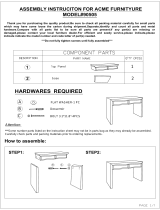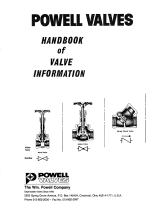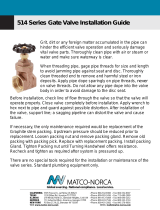
Flow Control
Vogt Valves
FCD VVAIM2000-01 Forged Steel Gate, Globe and Check Valves 19
(e.g., a deep radial groove cut by a retracting cutting tool or a
dent across the face caused by mishandling), until the condition
is corrected.
b) Check the bolting for proper size, length, and material. A carbon
steel bolt on a high-temperature flange joint can result in early
joint failure. High-strength material is always required for flange
bolting on steel flanges Class 400 or higher. Such bolting is
usually stamped “B-7” on the end, but other grades may be
used in some cases. The proper matching of flanges, bolting
and gaskets is important. Specific requirements of ASME B16.5
should be satisfied. Low-strength bolting may be used for lower-
pressure flanges, Classes 150 and 300 for operating tempera
-
tures not exceeding 400°F (204°C), when using approved gasket
materials. See ASME B16.5 for gasket specification.
c) Check the gasket materials. See ASME B16.5 for additional
requirements for flange joints using low-strength bolting, (e.g.,
gray iron flanges or Class 150 steel flanges). Metal gaskets (flat,
grooved, jacketed, corrugated, or spiral-wound), should not be
used with these flanges.
d) Check the gaskets for freedom from defects or damage.
e) Use care to provide good alignment of the flanges being as
-
sembled. Use suitable lubricants on the bolt threads. Sequence
the bolt tightening to make the initial contact of the flanges
and gaskets as flat and parallel as possible. Tighten the bolts
gradually and uniformly to avoid the tendency to twist one flange
relative to the other. Use of a torque wrench is helpful to ensure
correct and uniform final tightening of the flange bolting. Parallel
alignment of flanges is especially important when assembling
a valve into an existing system. It should be recognized that if
the flanges are not parallel, then it would be necessary to bend
something to make the flange joint tight. Simply forcing the
flanges together with the bolting may bend the pipe or it may
bend the valve. This is particularly true in large diameter piping.
Such conditions should always be brought to the attention of
someone capable of evaluating the bending condition and the
corrective measures that need to be taken. The assembly of
certain “short pattern” valves between mating flanges requires
that the installation be checked for any possibility of interference
between the moving parts of the valve and the adjacent pipe,
fitting, or valve.
a
CAUTION: Torque wrenches should always be used to
assure proper tightening of the flange bolting. If, in the
tightening process, the torque on a given bolt has been
increasing with each part turn and then is observed to
remain unchanged or increase a much lesser amount
with an additional part turn, that bolt is yielding. That
bolt should be replaced and scrapped since it is no
longer capable of maintaining the proper preload.
4.6 Weld Joint Assembly
Welded joints that are properly made provide a structural and
metallurgical continuity between the pipe and the valve body. It is
important that the joint should not constitute a “notch” or “weak
link” in the pipe-valve-pipe assembly. Therefore, the weld fillet for
socket weld joints must always have more cross sectional area than
the pipe.
Butt weld joints require full-penetration welds and a weld thickness
at least equal to that of the pipe. Welding a pipe of a high strength
alloy to a valve with body material of lower mechanical strength
requires that the weld taper to a compensating greater thickness at
the valve end.
Sound welds are obviously important.
a
CAUTION: This guide is not a complete welding instruction.
All welding should be in accordance with any Code or ju-
risdictional regulations applicable to the construction of the
piping system. The welds must be made following approved
welding procedures and be inspected as required by all ap-
plicable specifications. The following points are intended to
be helpful as point-of-use reminders of important require-
ments of good welding practice:
a) Consult the manufacturer for the correct installation procedure of
a metal-seated valve prior to pre-heating, welding and postweld
heat treatment of a butt weld or socket weld valve. To avoid the
possibility of arcing always attach the ground directly to the body.
b) Consult the manufacturer for the correct installation procedure
before welding a soft-seated valve into a line. As a minimum, a
soft-seated ball or plug valve should be in the full-open position
prior to welding to prevent seat damage and/or weld splatter
from adhering to the ball or plug. A means for venting the ball
cavity is recommended to relieve any fluid pressure that might
develop due to thermal effects.
c) Check materials marking on the pipe and valve to confirm that
they are as specified.
d) Inspect the welding end surfaces for dimensions and cleanli
-
ness. Correct any condition that might interfere with assembly
and satisfactory welding.
e) Check all backing rings that may be used to confirm that the ring
material is compatible with the pipe and valve materials and that
the individual rings fit and are clean.
f) Determine that all required welding parameters, including pre
-
heating and postweld heat treating, are in accordance with the
approved welding procedure.
g) Inspect the “valve to pipe end” alignment and adjust as required.

























